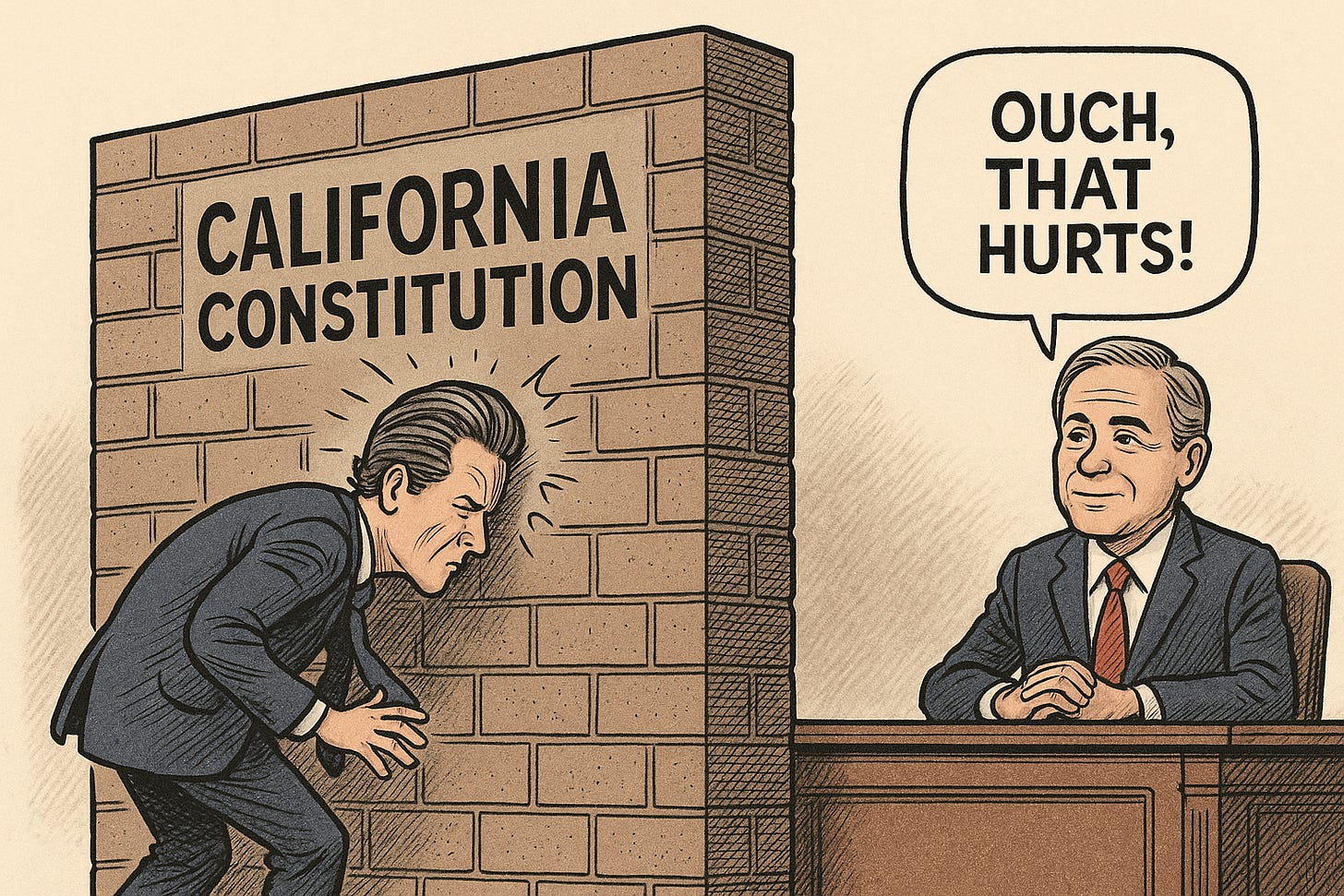[Corrected Version] Newsom’s Redistricting Gambit: A Risky Play to Reshape California’s Congressional Map, If He Even Means It
Governor Gavin Newsom floats mid-decade redistricting to counter GOP moves, but constitutional barriers and voter skepticism could halt his plans.
🕓 4 min read
**CORRECTED VERSON**
A Partisan Power Struggle
Governor Gavin Newsom has pulled California into a heated national conversation with his talk of redrawing the state’s 52 Congressional districts before next year’s elections. This move would completely overturn the once-a-decade process that follows the U.S. Census. While states typically redraw their districts every ten years to account for population changes, Newsom’s proposal, triggered by potential Republican maneuvers in places like Texas, seeks to tip the scales in favor of Democrats. California’s independent redistricting commission, carefully crafted to remove politics from map-drawing (whether it did that is the subject for a different column), now faces a direct assault. This represents a high-stakes gamble that puts the state’s dedication to fair representation and constitutional principles to the test.
Newsom’s Provocation on Pod Save America
Yesterday, Newsom appeared on Pod Save America, a lefty podcast hosted by Obama administration alums. Jon Favreau, a former chief speechwriter for Obama, hosted Newsom’s 16-minute interview with Favreau. I transcribed what Newsom exactly had to say (but you can watch the relevant two minutes of the interview here):
“I’m talking to members of my legislature—what are our alternatives? We could call a special session. I could call for one today, if I chose to. We could then put something on the ballot. And I could call a special election. We could change the constitution with the consent of the voters, and I think we would win that. I think people understand what’s at stake in California. They would come out in record numbers. I think it would be an extraordinary success. That’s a clean way of doing it. It would be a very short window. ‘Cause you got to come back with the maps. And you've got to change all this and prepare for the ballots that are around the corner next year. Or you can look at other avenues which we are exploring, which are pathways with the legislature to do urgency causes with 2/3 in both of our houses to move forward with legislative redistricting in between the constitutional construct, which is every census, the independent redistricting commission does a new map. But it’s silent about what happens in between. So it’s a novel legal question. And it’s being explored.”
Uh-huh. 🙄
Texas as the Catalyst
Newsom’s remarks came as a direct response to what is happening in Texas, where just last week, Republican Governor Greg Abbott called a special legislative session to consider “a revised congressional redistricting plan,” pointing to a U.S. Department of Justice letter signed by Assistant Attorney General Harmeet Dhillon that alleged racial gerrymandering in four Democratic-held districts. President Trump’s team appears to be pushing Texas to move GOP voters into blue districts, specifically targeting seats like those held by Representatives Henry Cuellar and Vicente Gonzalez, which Trump won in 2024. Trump told reporters yesterday, “We pick up five seats,” hoping to strengthen the GOP’s narrow 220-212 House majority.
A Constitutional Roadblock
The constitution has a process to reject a commission-drawn map via voter referendum. If a map were overturned, the State Supreme Court appoints a new group to redraw it, not the legislature. This clear language, enshrined by voters in 2008 and 2010, makes it pretty clear that there is an intended way to contest maps with which people are dissatisfied — and it is not the legislature simply redrawing them whenever and however it would like.
The Special Election Squeeze
Newsom’s alternative—a special election to amend the constitution—faces a punishing timeline. If the legislature writes a ballot measure tomorrow and Newsom calls a special election, the earliest almost unrealistic date would be mid-October. Certification could drag on for weeks, leaving a tiny window to redraw maps, approve them, and update election infrastructure before February’s candidate filing deadline. Legal challenges are practically guaranteed, especially with federal angles that could end up in courts far less sympathetic than California’s Supreme Court, where six of seven justices were appointed by Democratic governors. Such litigation could easily derail the entire process.
Can Newsom Sell It?
The biggest obstacle may be convincing Californians to abandon their independent redistricting commission, which was specifically created to prevent politicians from drawing their lines. Newsom’s argument—“Republicans are gerrymandering, so we must too”—asks voters to return to a system where legislators craft districts to help Democrats, who already control 42 of 52 House seats. This could easily be viewed as a naked power grab, particularly if it ties to Newsom’s Presidential ambitions. National money would pour in from both sides, transforming the campaign into a brutal, high-stakes battle. The fight would be intense with Newsom’s Attorney General writing favorable ballot language. However, persuading voters to abandon a system they approved by over 20% in 2010 represents a steep uphill climb.
So, Does It Matter?
Newsom’s redistricting talk, delivered on a platform designed for Democratic loyalists, feels more like political theater than serious policy. California’s constitutional protections and voter commitment to independent redistricting make his plans a long shot at best. If Newsom keeps up the drumbeat, more knowledgeable voices in redistricting circles will weigh in on all this. But from where I sit, Californians actually voting in different Congressional Districts in 2026 is very, very, very unlikely.
** Correction: The initial version of this column incorrectly states that there was a flat-out prohibition in the State Constitution of the State Legislature redrawing maps passed by the commission. This has been fixed in this version.




